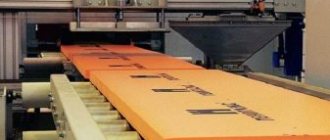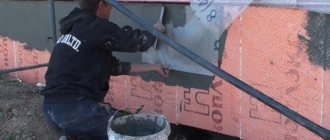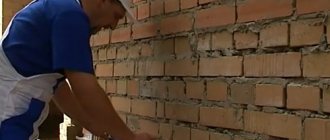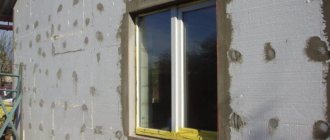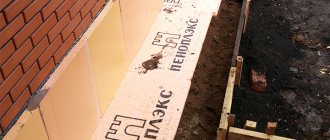Modes of using a bathhouse and the need for external insulation
If the owner expects occasional use of the object for its intended purpose (no more than once a week), he expects the steam room to completely cool down between sessions.
That is, internal insulation is arranged based on rapid heating with a rise in temperature from the street temperature to 60 ° C - 90 ° C. In this case, installing thermal insulation on the street side does not make sense: in winter, this measure will not save the building from freezing for 3-4 days. The cooling of the room will slow down, but in the end, almost as much energy will need to be spent on each heating as in the absence of external insulation. Insulation of bath walls from inside and outside
When using a steam room every 2 - 3 days, the question is “how to cover the outside of the bathhouse?” is no longer idle for materials with high heat capacity (brick, concrete). Daily use (for example, for commercial purposes) makes it advisable to cover the bathhouse with insulating materials on both sides, regardless of the type of load-bearing walls.
Another option for using a bathhouse that justifies double-sided insulation, regardless of the heat capacity and vapor permeability of the rough walls, is to conduct several paired sessions within one day. At the same time, the bathing day itself may not be repeated often.
Sequence of insulation work
- The very first stage of insulation will begin during the assembly of the log house, when an organic fibrous heat insulator will have to be laid between its elements : tow, jute, flax wool, dried moss or a combination of them.
Only after six months can this process be completed using a hammer and caulk (a special spatula), carefully sealing the ends of the fibers into the seam. True, synthetic sealants have also appeared for this purpose, but for a bath it is especially important to maintain environmental safety under conditions of heating and evaporation.
- When laying a bathhouse, you can take measures to insulate the floors, especially if they are constructed of concrete. In this case, you will have to perform ground leveling work, pouring sand and expanded clay; pouring the base floor.
- How to insulate the ceiling and walls of a bathhouse? Insulation is carried out from the inside and outside, but after the process of shrinkage of the structure has been completed.
- Measures for insulating windows and doors, external and internal cladding work to preserve heat in the bathhouse premises.
How to insulate a bathhouse from the outside
To insulate a bathhouse from the outside, two technologies are used: “wet facade” and “ventilated facade”. In the first case, the thermal insulation is slabs of polystyrene foam, expanded polystyrene or basalt wool. First, they are glued to the wall with foam, additionally secured with plastic dowels and umbrellas, and decorative plaster is applied on top. In the second case, a lathing is attached to the wall of the bathhouse. The cells are filled with mineral wool or basalt slabs, covered with windproof film, and a counter-lattish is filled onto which the facing material is attached. A gap remains between the film and the lining, forming a ventilated space.
Insulation using mineral wool insulation
Mineral wool insulation has been used for several decades, and judging by the fact that the number of products on this basis continues to grow, there is still a demand for it. An alternative to mineral wool is Rockwool Sauna Butts for baths.
Despite the fact that there are now many other insulators that are higher quality, more reliable and easier to use, such materials are still relevant.
Mineral wool is usually sold in rolls or slabs. For walls, of course, the second option is more convenient - rolls are best used for horizontal surfaces. In addition, it can be used to insulate the ceiling in a bathhouse.
The thermal conductivity of the product is not the best: this indicator is around 0.04 W/mK (depending on the type and brand). However, since the insulation will be attached from the outside, this is not a significant drawback - it can simply be used in a thick layer. But some properties of mineral wool make it not the most successful material:
- poor resistance to moisture - when exposed to moisture, the material crumples and cakes;
- increased complexity of work (compared to foam plastic);
- the need to use protective equipment for the skin and face.
One of the tangible advantages (besides the relative cheapness) is the fact that mineral wool can be mounted even on uneven wall surfaces that have protrusions and differences in height.
The process itself, if you do it yourself, looks something like this (the list of steps is the same for both a brick bathhouse and a building made from expanded clay concrete blocks):
- The surface of the walls is checked - there should be no cracks, chips or holes on them. If there are any, they should be sealed with plaster.
- The surface of the walls is primed at least once.
- Wooden sheathing is being installed.
- A vapor barrier film is glued to the wall (you can skip this point).
- Insulation is laid between the sheathing.
- A waterproofing film is stretched over the sheathing (when insulating with mineral wool, this is a mandatory nuance).
- Installation of facing material is in progress.
Insulation with foam or polystyrene foam
Insulators from the category of gas-filled plastics have also been known for quite a long time. The brightest and most popular representative is ordinary polystyrene foam. This insulation is extremely easy to use - you can easily install the blocks yourself, even if you didn’t even know how to do it before.
It is not surprising that this particular material is widely and universally used for insulating various parts of buildings, including as insulation for saunas.
Its higher quality and more efficient “brother” is extruded polystyrene foam. This insulation has better thermal conductivity (approximately 0.03-0.035 versus 0.04 for polystyrene foam) and is completely resistant to moisture. By the way, the thermal insulation of baths and saunas can be done with his participation.
The materials themselves are similar in appearance, light in weight (which, again, simplifies DIY work) and are absolutely identical in terms of application. By the way, as for the work itself, such insulation does not require any precautions (like mineral wool).
However, laying blocks requires a perfectly flat surface, which complicates the process somewhat. The sequence of do-it-yourself actions is as follows (the same for both a brick building and a structure made of expanded clay concrete blocks):
- The surface of the walls is checked - there should be no cracks, chips or holes on them. If there are any, they should be sealed with plaster, then insulation for the walls of the bathhouse is applied.
- The surface of the walls is primed at least once.
- Starting from the bottom corner (any) and moving sideways, the foam/EPS is glued to the surface using a special adhesive solution (sold in the same place as the insulation itself).
- Each of the blocks is additionally fixed with self-tapping screws (approximately 5 pieces per 1 sheet).
- The joints between the sheets are taped or foamed. Alternatively, you can simply cover them with plaster.
- A waterproofing film is stretched over the insulation onto the sheathing.
- Installation of the facing layer and further finishing are carried out.
Insulation using sprayed polyurethane foam
A relatively new insulation technology is spraying polyurethane foam. This insulator is a liquid insulator - it is obtained by mixing two components. Preparation is carried out directly at the work site, in a special installation.
The container of such units is equipped with a stirrer to maintain the desired consistency of the solution. Higher quality and more expensive models are also equipped with heating (necessary for the same purposes).
The selection of insulation for a bath can be based on this material. The insulation itself can safely be called ideal: it is lightweight, not afraid of moisture or any other negative factors (rodents, mold), and has minimal thermal conductivity (around 0.025 W/mK).
Interesting: What type of wood is best to build a bathhouse from: what to look for when choosing
In addition, the surface of expanded clay concrete (or any other) walls does not require leveling, and the resulting insulation layer is monolithic and has no seams or joints.
Its main disadvantage is the impossibility of using it yourself: the above-mentioned special installation is expensive. And the spraying service itself is also expensive.
To familiarize yourself, here is the sequence of actions when using this technology:
- The surface is checked for cracks and chips. If available, they are covered with plaster.
- PPU is being prepared.
- The sheathing is mounted on the wall.
- PPU is sprayed onto the surface.
- On top of the insulation, along the sheathing, the cladding is installed and further finishing is carried out.
Ventilated facade method

If the bathhouse is built using frame technology or the walls are made of timber or logs, the outside can only be insulated by installing a ventilated façade. For thermal insulation it is better to use basalt slabs. Rolled mineral wool sags over time, slides, and does not hold well between the sheathing elements.

Insulation from the outside begins with preparing the walls. First, they caulk the cracks and crevices between the crowns. The wood is treated with a protective impregnation. Rotten areas must be replaced. A vapor barrier is attached to the prepared wooden wall of the bathhouse.
Advice! It is better to use a special membrane as a vapor barrier for wooden bath walls.
The location of the sheathing elements is drawn using the vapor barrier material. Along the marked lines, brackets in the form of U-shaped perforated plates are attached to the walls. Pieces of roofing felt are placed under each element. The lathing is assembled from a galvanized profile or wooden blocks. The elements are fixed to perforated brackets with self-tapping screws.
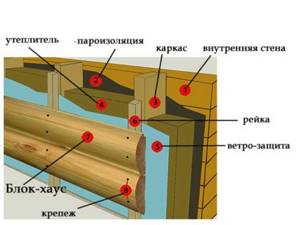
When the sheathing is ready, they begin to insulate the walls of the bathhouse. Basalt wool is placed between the vertical elements. The slabs must fit tightly without gaps. The top of the insulation is covered with wind protection. The film is fixed with a stapler to the sheathing elements.
To create a ventilated space under the cladding, slats are nailed onto the vertical elements of the sheathing on top of the windbreak, forming a counter-lattice. The cladding is attached from any panels you like. To insulate the outside of a bathhouse, the Block House, which imitates a log house, is most often chosen.
Advice! If desired, the “ventilated facade” technology can be used for bathhouses made of bricks, blocks and other materials.
How to insulate a bathhouse ceiling from the outside

Inside the bathhouse, the ceiling is insulated in the same way as the walls, and a ventilated space is provided. From the outside of the attic, another technology is used. When the rough board ceiling is lined, it is covered with two layers of fiberglass. It is not advisable to use roofing material, since heating will cause an unpleasant smell of bitumen to appear inside the steam room.
Even rolled mineral wool can serve as thermal insulation, but in order to save money, natural materials are used for insulation. The space between the beams is filled with expanded clay. Kneading clay with the addition of fine straw, shavings, and sawdust is suitable.
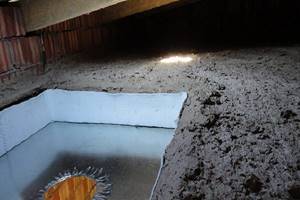
When the clay pouring hardens and dries, slabs of polystyrene foam or expanded polystyrene are laid on top. The thermal insulation is covered with waterproofing, and a thin concrete screed is poured. You can even walk on this surface. If the attic of the bathhouse is allocated for a rest room, after insulation the final layer is laid on the finished floor.
Insulation of a bathhouse building with expanded clay
The insulation of this class is natural. The use of expanded clay has been justified over the years and by positive reviews from craftsmen. Expanded clay is used to insulate floors in bathhouses and attics, and to some extent it can be used to insulate walls.
The backfill is made into the well masonry. This is the only option. Another way would be to make blocks with the addition of expanded clay. Laying walls from such material will allow you to do without additional insulation. Only external protection with plaster in order to give an aesthetic appearance.
On a note. Expanded clay is an inexpensive material and if we consider it as an option for insulating bathhouse walls, the cost savings will be significant. But when planning to carry out the entire process yourself, be prepared for high technological requirements, especially in terms of preparing blocks for laying walls.
The bathhouse is a sacred place for most people who know a lot about procedures. In order for the steam room to please you with a strong “park” and at the same time the prices on your payment do not frighten you with huge bills, you need to take care in advance about insulating the walls outside and, in some cases, inside the building.
Questions about how to insulate a bathhouse from the outside or inside, and how to do it correctly, have already given many sleepless nights to many owners of private households. After all, it’s no secret that in order to fully enjoy your vacation, inside a building you need an easily created and maintained microclimate that is optimal for each room. To a greater extent, it will depend on the thermophysical properties of the enclosing structures. For example, a steam room should not only heat up quickly, but also maintain the set temperature parameters for as long as possible. At the same time, you could calmly be in the rest room, covering yourself with only a towel. And even if you install a super-powerful heat generator, burn exorbitant amounts of fuel or spend extra tens of kilowatts of electricity, and leave the walls “cold” - with a high degree of heat transfer, then there will always be unpleasant drafts inside the structure.
Continuous external thermal insulation depending on the material of the load-bearing walls
How to insulate a bathhouse from the outside if it is not intended to seal the joints, but rather to install a thermal insulating lining? Let's look at the types of load-bearing walls:
Before insulating a bathhouse, it is necessary to correctly calculate the thickness of the insulation layer
- Brickwork or concrete structure. The types are combined into one category because they relate to inertial buildings with high heat capacity and high permissible moisture accumulation.
- Foam concrete and gas blocks. They occupy an intermediate position between log houses and brick baths.
- Log house Requires strict consideration of the relative vapor permeability of each layer of the insulating sandwich.
How to insulate a log sauna from the outside
Almost all insulation of a log bath comes down to carefully sealing the cracks. Even during construction, a special jute insulation was laid between the crowns, but over time the wood dries out, cracks, and new cracks form, which need to be caulked regularly.

Insulation of a log bath
After erecting the frame and caulking the cracks, the building must remain under the roof for at least six months. It is advisable not to use the bathhouse during this time. The log house will shrink, the wood will dry out, and new cracks and gaps will appear. These are the ones that need to be caulked. For this purpose, a special insulation based on jute and flax is used. Jute itself conducts heat poorly and does not burn, but its disadvantage is low elasticity (it tears easily). To solve this problem, flax fibers are added to the insulation for log houses. Thin strips of material are driven into the cracks using a hammer and a special metal caulking blade. This must be done carefully to prevent distortion of the structure.
There is also a special sealant for sealing cracks in wooden buildings. It’s easier to work with: a special syringe fills all available voids.

Insulating a log bath using sealant
A log house shrinks within two years. At this time, it is not recommended to cover it with finishing materials. This way you will have access to newly appearing cracks that need to be periodically sealed from the inside and outside. To protect the insulation from the effects of precipitation, the outside of the building can be covered with film, securing it with strips.
Two years after construction, you can begin finishing. For many this will sound ridiculous, but structures made of logs can be sheathed with a block house, clapboard, imitation timber, or dies. To begin with, a sheathing is mounted on the wall (if it is made of wood, it must be treated with antibacterial impregnations and increases resistance to fire), which is checked for verticality and horizontality using a building level.
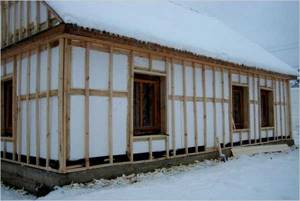
Lathing for insulation and finishing
Finishing material is attached to the sheathing, which is then coated with varnish or other protective compounds. If you choose metal guides, they are mounted on special hangers.
Insulation on the outside of a log bath is almost never used, and the inside is only sometimes additionally insulated in the steam room and washing room. If you decide to play it safe and insulate the building, if the insulation is afraid of moisture, a vapor or water barrier is laid on top of it. It is secured using strips, onto which the trim is subsequently attached.
Insulation of a bathhouse made of timber from the outside
The insulation of a bathhouse made of timber from the outside is absolutely no different from the insulation of a bathhouse made of logs. The building must also stand, cracks also appear in it, which are sealed in the same way.
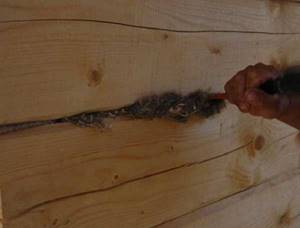
Insulation of a bathhouse made of timber
The need for external insulation depends on the thickness of the timber. If its thickness is insufficient for your climate zone, insulation will need to be done according to the following scheme:
- lathing made of timber or metal guides (be sure to align them in both horizontal and vertical planes);
- heat insulator (thickness depends on the climate zone, wall thickness, and type of thermal insulation);
- moisture and wind protection;
- counter lathing (not necessary, but there should be a gap between the protective film and finishing materials);
- Decoration Materials.

outside of a bathhouse is usually sheathed from timber: clapboard of any type, edged board, siding, metal profile, block house, etc. After completion of the work, the wooden finish is coated with varnishes for exterior use, sometimes pre-treated with coloring pigments, but many modern compositions also have a tinting effect, which, of course, is convenient.
If siding is used as a finishing material, then the presence of a ventilation gap between the insulation and the finishing is mandatory. In this case, it is advisable to use special guides as lathing, which can be purchased in the same place where siding is purchased. The guides are mounted on special hangers.

Metal siding guides are mounted on special hangers
Insulation of a brick bathhouse from the outside
It is imperative to insulate a brick bathhouse from the outside - this material has high thermal conductivity, so without external insulation it will be extremely difficult to warm the room to the required conditions. The sequence of insulation is the same: frame, insulation, moisture and wind insulation, ventilation gap, sheathing.

Insulation scheme for a brick bath
For external insulation, it is usually recommended to use mineral wool. According to recent studies, they are not suitable for internal insulation of a bathhouse - they emit formaldehyde, but for external insulation they are one of the best options. You can also insulate a brick bathhouse from the outside with polystyrene foam boards, polystyrene foam (it is cheaper, but polystyrene is more durable), foam glass (its disadvantage is its high price). To ensure high-quality work, it is recommended to lay two layers intercut (offset by half the length) to reduce heat loss by overlapping the seams. But this method takes more time, and it takes twice as much materials for insulation. Therefore, most often, insulation is done in one layer, tightly laying one mat to another, and the joints are taped with reinforced tape.
Interesting: How to install lining correctly: how to fix it yourself
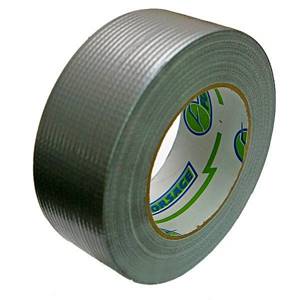
Fabric reinforced PVC tape
To cover the outside of a brick bathhouse, you can use wooden finishing materials or siding. There is another option for exterior finishing: you can decorate the outside of the bathhouse with plaster. This is possible if polystyrene boards, foam glass or foam plastic were used as insulation. Then a reinforcing mesh is placed on top of this material, a primer is applied, and then the walls are plastered.
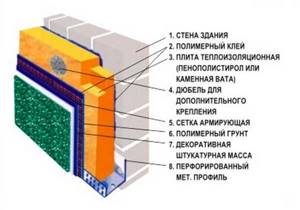
Scheme of insulation of a brick bath and finishing with plaster
You can insulate a brick bathhouse using the type of ventilated facade. In this case, special L-shaped brackets are attached to the wall (the installation step is 1 cm less than the width of the insulation), between which mats or insulation boards are tightly installed.

Insulation scheme for a brick bathhouse based on the principle of a ventilated facade
For reliability, they can be reinforced with special dowels, but this is not necessary - the material itself must hold quite firmly (that’s why they make the fastening step of the guides 1 cm less than the width of the insulation - it is held in place by elastic force). The joints of the slabs are glued with reinforced tape, or treated with special glue, a waterproofing film is laid on top, and secured with strips. Now guides are installed on the brackets, which support the insulation and at the same time serve as the basis for installing the exterior trim. Using this scheme, you can also insulate baths made of foam blocks, cinder blocks or aerated concrete.
Finishing the outside of a bathhouse made of blocks
Any of the insulation schemes described above can be applied to block baths. In addition, there is another option: to cover such a bathhouse with decorative bricks, but this option of finishing and insulation is possible if the temperature in the bathhouse is maintained above zero at all times.
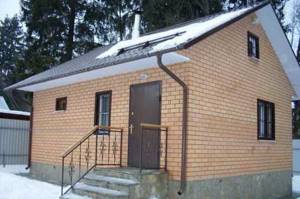
Exterior decoration of the bathhouse with decorative bricks
If you decide to line a bathhouse made of blocks with bricks, you can lay out the second wall not closely, but retreating 5-10 centimeters. In this case, the thermal insulation characteristics of the building will be much improved. The gap can be left empty, or it can be filled with thermal insulation material: expanded clay, sawdust that has undergone special treatment, etc.
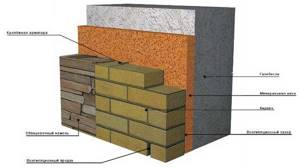
Insulation scheme for aerated concrete baths
To prevent moisture from accumulating in the space between the walls, small ventilation gaps are left in the outer wall, and to securely fix the finishing wall, small pieces of fastening reinforcement are driven into the load-bearing wall.
Recently, finishing material such as a block house, which emits a log wall, has become increasingly popular. Block houses are made from different materials: PVC (vinyl), metal or wood. A bathhouse made of blocks, lined with a block house, looks as if it is made of wood.

Block bathhouse covered with a block house
We select materials
Today, many effective thermal insulation materials have already been created with similar thermal conductivity coefficients λ = 0.03-0.04 W/m*C. This is where their similarities sometimes end, since there are a number of other important parameters on which the technologies for their use depend. The most important characteristic for insulating the walls of a bathhouse from the outside is also the coefficient of vapor permeability (μ, mg/m*h*Pa). After all, no matter how good a vapor barrier you make, moist air will find ways to migrate through the walls to the outside. Therefore, steam must be able to freely evaporate into the atmosphere without accumulating inside walls or insulating material. Otherwise, accumulation of dampness cannot be avoided, which can lead to damage and destruction of both the wall itself and the thermal insulation. To avoid this, you should follow two rules:
- Minimize the amount of migrating steam through the building envelope. The solution is to install a high-quality insulating membrane from the inside of the building and arrange effective ventilation of the premises.
- Providing conditions for free diffusion of steam. Solution - materials are selected according to the condition that their coefficient μ increases towards the outer surface of the building.

Figure 3
Is it possible to insulate a bathhouse with foam plastic from the outside?
Even if we do not take into account the low environmental performance of expanded polystyrene (EPS, EPS) and its fire hazard, then installing such slabs on walls almost completely blocks the migration of moisture. In addition, insulating a bathhouse with foam plastic violates the principle of the ratio of the coefficient μ between the internal and external layers. Paying attention to the data from Table 1 for the most likely combinations of materials, it becomes clear that the steam simply will not have time to erode through the sheathing slabs.
As a result, condensation will begin to accumulate on the outer boundary surface of the wall, with all the ensuing (literally and figuratively) negative consequences.
Table 1.
| Popular wall and insulation materials | Vapor permeability coefficient μ, mg/m*h*Pa |
| PPS (density 10-38 kg/m3) | 0,05 |
| EPPS | 0,001-0,005 |
| Minvata | 0,3-0,55 |
| Ecowool | 0,3-0,67 |
| Pine log | 0,06 |
| Brick | 0,11-0,14 |
| Foam and aerated concrete | 0,11-0,23 |
From the same table 1, it is obvious that whether it is insulating a wooden bathhouse, brick or foam blocks, an increase in the coefficient of vapor permeability to the outside is possible if the enclosing structures are covered with mineral wool or ecowool. Then, all the steam that has penetrated into the layer of thermal insulation from the walls will have time to erode.
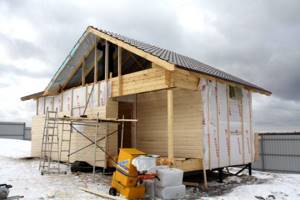
Figure 4
Is it necessary to insulate the foundation of a bathhouse from the outside?
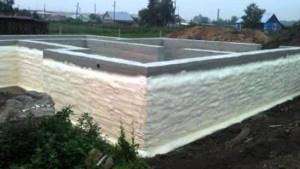
To make sure of the importance of external foundation insulation, it is worth considering 5 reasons:
- On a cold foundation in winter, a temperature difference forms in a heated bathhouse. The resulting condensation destroys the concrete base.
- The problem with condensation occurs even in summer. An uninsulated foundation is heated by the sun from the outside, but the cold and moisture of the earth is drawn from the inside. The temperature difference is similar.
- A foundation that is not insulated from the outside cools the steam room faster. The bathhouse has to be heated more often.
- On the outside, thermal insulation in winter softens the impact of heaving soil on the foundation.
- A thick layer of thermal insulation on the outside protects the foundation from destruction and accidental mechanical influences.
The listed 5 reasons convince us that insulating the foundation of a bathhouse from the outside is necessary. It can be carried out simultaneously with thermal insulation from the inside. It is impossible to do only internal insulation of the base of the bathhouse. Due to temperature changes, concrete will begin to collapse on the street side.
How to insulate the foundation of a bathhouse from the outside with your own hands

There are different ways to insulate the base from the outside. They all depend on the type of soil where the bathhouse is built, as well as on the design of the foundation itself.
The strip foundation is dug around the outside with a trench 50 cm wide. The depth is maintained at least 80 cm. A 20 cm layer of sand is poured into the trench. The concrete strip is cleaned of dirt and treated with hot bitumen. After the waterproofing has hardened, the base is covered with polystyrene foam or polystyrene foam. Plates 15 cm thick are glued with foam and additionally secured with dowels and umbrellas. When using expanded polystyrene, the gap between the trench wall and the insulation is filled with sand. The foam is covered with a brick wall. From above, the entire pie around the base is filled with a concrete blind area at an angle of 15 degrees.
A monolithic foundation is usually laid under a bathhouse in a swampy area. The base is insulated during the construction stage. Expanded polystyrene is embedded between the layers of concrete screed. On the walls outside the foundation of the bathhouse, insulation with your own hands occurs according to the principle of a strip base.
The columnar foundation creates a gap between the soil and the lower crown of the bathhouse. To insulate it, it needs to be bricked. First, a trench is dug along the perimeter of the bathhouse. The parameters are the same as for insulating a concrete strip. The bottom of the trench is covered with a 25 cm layer of sand and filled with water. When the pillow is compacted, they begin to lay out the wall. Concrete can be poured up to the ground level, and rows of bricks can be laid above. A gap is left between the last row and the crown of the bath and filled with polyurethane foam. The built base is insulated from the outside using the strip foundation method.
Practical aspects of insulating a bathhouse from the outside with your own hands
By choosing to manufacture an external heat shield with a ventilated gap, you get a reliable, durable façade system. If you show maximum care and use only materials recommended for these types of work, then the exterior of your building will delight you for many years, and it will not require repairs.
So, let’s look at the practical aspects of how to insulate a bathhouse from the outside with your own hands. We believe that the internal vapor barrier layer has already been installed or will be installed at the stage of cladding the premises.
Walls
Walls made of brick or other block building materials are inspected for cracks or voids in the seams, which should be additionally strengthened with mortar (rubbed, embroidered). It’s even better if the sides of the rooms are completely covered with a layer of vapor-proof plaster.
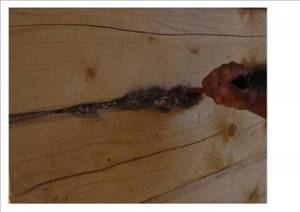
According to classical technology, insulation of walls in a bathhouse, the frame of which is made of logs or timber, begins with caulking with tow, flax strands, jute or other natural materials. It is best to perform the operation after the complete shrinkage of the structure, which depends on the timing of the initial moisture content of the wood (can last for several years). Otherwise, cracks will still appear, and eliminating them under the inner and outer cladding will be problematic.

There is also a more modern method of sealing crown and other cracks using sealants. For bathhouse walls made of wood with normal humidity, it can be used almost immediately after their construction, but “raw” log houses should still be allowed to stand for at least six months. Usually they wait out the winter, and closer to summer they begin to process the seams.
Interesting: Lining the inside of a bathhouse with clapboard - step-by-step instructions for finishing it yourself
This type of sealing, unlike the classical one, guarantees stable functionality regardless of the occurrence of multidirectional deformations of the wood. Synthetic sealants have good adhesion to the substrate and work for both compression and elongation up to 300%. Before using them, the seams of the bathhouse walls from the outside are primed and sealed with a cord made of extruded polyethylene foam. The method of laying the sealant depends on its packaging. The most convenient way is tape - the protective film is removed from it, it is placed in the seam and rolled with a roller. If you purchased the composition in tubes for a mounting gun or buckets, then after application it still needs to be smoothed with a spatula.

Energy saving screen frame
Insulating baths on the outer surface of the walls using mineral wool or ecowool requires the installation of a frame support. Initially, it will serve to securely attach a layer of effective thermal insulation to the enclosing structures, and then to fix the wind barrier and install the façade cladding. The frame can consist of one or two tiers. The second type, with a cross-layer arrangement, provides the best thermal protection characteristics.
Thermal insulating layer
The principles for choosing the type of thermal insulation have already been discussed above, in the section “Selecting materials”. If you give preference to ecowool, then, although it is an effective material, you will have to involve third-party specialists who have the appropriate equipment for applying it under pressure. The existing alternative method of free backfilling of ecowool is not the most successful solution for walls, since its column becomes compacted and subsides over time, which leads to a violation of the integrity of the thermal contour of the building. Therefore, it is easier to organize the insulation of a bathhouse with your own hands using mineral wool products made from glass or stone fiber.
Attention! When purchasing such products, you should carefully familiarize yourself with the scope of their application. For example, it may be intended to solve problems of acoustics or fire protection, while its thermal resistance will be inferior to the corresponding profile materials.
Manufacturers of mineral thermal insulating wool produce it in both standard or universal versions, as well as specialized products for assembling ventilated facades. Narrow-profile products can have useful advantages:
- tongue-and-groove locks along the perimeter of the slabs, simplifying the insulation of bathhouse walls, and also eliminating air circulation at the joints, even with a single-layer placement;
- fiberglass coating, which reduces the movement of convective flows through the insulating layer;
- additional hydrophobic impregnation, due to which the droplet liquid is not held between the fibers, but flows down freely.
Universal or specialized mineral wool used for facade systems of utility buildings must have a density of at least 35-40 kg/m3. With a decrease in this parameter, heat transfer in all its forms increases: convection, thermal conductivity and radiation. The maximum density, for reasons of profitability, is usually chosen no higher than 80 kg/m3, since heavier and more expensive products are already used in industry.
Fixation of insulation boards on the walls of the bathhouse is carried out due to their tight fit in the frame of the sheathing and point compression with disc-shaped dowels.

Wind protection and ventilation gap
The windproof fabric is secured to the vertical elements of the supporting frame using spacer slats for a ventilated gap. In this case, preference should be given to special vapor-permeable wind-moisture-proof membranes, which are rolled directly over the layer of insulation for the bath.
Important! For such installation, the use of roofing felt, PE films and other sealed materials is not allowed. The vapor permeability of the wind barrier should be at least 700-800 g*/m2 per day.
The joints of the strips are glued with tape intended for such work. The average overlap of adjacent panels is 15 cm, and the width of the ventilation gap between them and the cladding ranges from 2 cm to 5 cm (the parameters are set by the manufacturer).
Facade cladding
One of the main advantages of ventilated facades is that, regardless of the type of building frame and its condition, you can sheathe the outside of the bathhouse with one of the materials available on the construction market in a wide range. This can be vinyl or metal siding, lining, block house, fiber cement board, or other hanging cladding. This type of finishing is installed according to similar schemes, the main uniqueness of which is dictated by the dimension of the spacer sheathing step. For example, for vinyl siding it is about 40 cm.
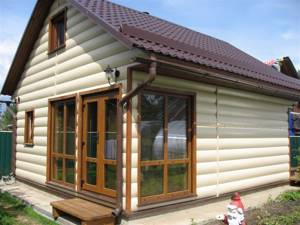
External insulation of a bathhouse using a ventilated facade system allows not only to solve energy saving issues for new buildings, it can radically change the aesthetic characteristics of even a dilapidated building, practically providing it with a new life.
Tips and tricks
- First of all, do not forget that heated air masses can exit the bathhouse through the windows. And for this reason, you should give preference to small windows. What is also important, experts recommend, if possible, installing frames with more than one double-glazed window. And it is best to have 2 or 3 double-glazed windows (the more, the better, because this will prevent the rapid evaporation of warm air from the bathhouse).

Small window in the bathhouse - photo
- Doors and thresholds have an important influence on the thermal insulation in your bathhouse. Quite often, specialists are contacted with the problem of rapid evaporation of air from the bathhouse. And the reason for this in 90% is the gap between the threshold and the door, due to which all the heat evaporates. To be sure that you will not encounter a similar problem, it is best to install low doors with a high threshold.

It is recommended to install small doors with a high threshold
- Due attention should be paid to the heater. After all, the intensity of heating the bath and how long the warm air will be retained in it will directly depend on the heat capacity of the stones.
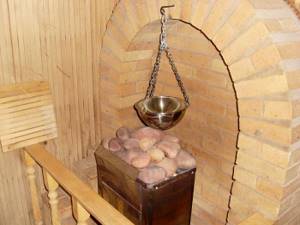
Stove-heater
Requirements for a log house
The quality of thermal insulation of a bathhouse also depends on the log wood and the degree of its preparation for use. For making a bathhouse from timber, the best tree species growing in our country are: cedar and oak. But, due to the high cost of these materials, the beams are most often made from spruce, less often from linden or aspen. Birch, as a material for making timber, due to some of its properties, is not suitable.
Here's what you need to know about wood:
- the best wood is “winter”, which is harvested from December to March;
- you can start making beams only a month after the tree has been cut down;
- The timber must be stored by laying it out with an air gap of 5 cm on pads 20 cm thick under an open canopy;
- deep cracks in wood are not allowed;
- The presence of even the slightest traces of wood damage by wood pests or signs of rotting on the beams is not allowed;
- the wood should not contain resin pockets.
It is not recommended to order a ready-made log house, since some links may become warped due to storage problems. It is preferable to purchase separate bars of the required length.
Myths about the purposes and results of external insulation
You can often find the following statements in informational texts and forums:
- “A brick bathhouse must be insulated from the outside. Otherwise, heating it to the required temperature will be problematic.” Note: the speed of heating a steam room depends to a much greater extent on the proper arrangement of internal insulation.
- “For polystyrene foam, it is best to use the “wet facade” finishing system so that the wall “breathes.” Note: EPS boards have practically zero vapor permeability, which cannot be increased by any coatings.
- “You can buy foam glass granulate relatively cheaply and use it as a filler for heat-saving cladding blocks.” Note: such granulate, both in the form of backfill and as the basis for the formation of cellular concrete, is an order of magnitude inferior to the heat-shielding properties of block foam glass. In fact, it is no better than expanded clay.
Positive aspects of artificial insulation
Such materials include all types of polymers and fiber boards, in the production of which components of non-natural origin were used. In terms of the quality of wall insulation, they are not inferior to natural insulators, they are environmentally friendly, have a high degree of protection not only from cold, but also from noise, and most importantly, there are no restrictions on installing artificial insulation with your own hands.
Special mention should be made of foam glass. This is the only insulator that combines a lot of positive qualities:
- frost resistance;
- strength;
- environmental friendliness;
- non-flammability;
- durability;
- easy installation.
Polymers, about which quite a lot has already been said, are no less reliable. The walls of the bathhouse, insulated from the outside with foam or polystyrene slabs, will not allow heat to pass through. The operation of electrical equipment or a wood stove will be aimed only at heating the interior space. At the same time, it will take less time to warm up, which means energy costs will also decrease.





